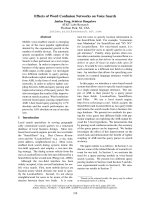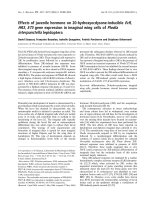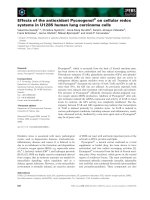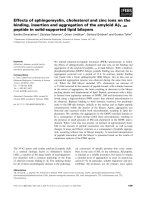Báo cáo khoa học: "Effects of lime-induced differences in site on fine roots of oak" pptx
Bạn đang xem bản rút gọn của tài liệu. Xem và tải ngay bản đầy đủ của tài liệu tại đây (637.92 KB, 8 trang )
Original
article
Effects
of
lime-induced
differences
in
site
fertility
on
fine
roots
of
oak
Mark
R.
Bakker
Claude
Nys’
Équipe
cycles
biogéochimiques,
Inra
Nancy,
54280
Champenoux,
France
(Received
9
March
1999 ;
accepted
9
June
1999)
Abstract -
This
study
aims
at
evaluating
the
effects
of
lime-induced
differences
in
site
fertility
on
fine
roots.
Lime
was
applied
to
ten
oak
(Quercus
petraea
and
Q.
robur)
stands
on
acidic
soils
with
low
base
saturation,
1-27
years
before
fine
root
sampling.
The
soil
exchangeable
nutrient
pool,
fine
root
and
foliar
composition
all
showed
deficient
levels
for
at
least
a
number
of
elements.
Liming
enhanced
fine
root
biomass
both
in
topsoil
and
in
deeper
horizons,
and
overall
fertility
and
nutrition
were
improved
for
Ca
and
Mg
but
not
for
K
and
P.
Thus,
liming
in
moderate
doses
on
acidic
sites
showing
nutrient
deficiencies
may
stimulate
the
absorbing
capaci-
ty
of
the
tree
root
system
by
enlarging
fine
root
standing
crop
and
thereby
improving
uptake
of mineral
nutrients
and
stand
growth.
However,
one
should
bear
in
mind
that
resolving
a
deficiency
for
some
elements
can
create
less
favourable
conditions
for
others.
©
1999
Éditions
scientifiques
et
médicales
Elsevier
SAS.
fine
roots
/
liming
/
mineral
nutrition
/
Quercus
/
soil
Résumé -
Conséquences,
après
amendement,
d’un
changement
de
fertilité
sur
les
racines
fines
de
chêne.
Cette
étude
évalue
l’effet
des
changements
induits
au
niveau
de
la
fertilité
du
sol
par
des
amendements
calciques
et
ses
conséquences
sur
les
racines
fines.
Les
amendements
calciques
ont
été
appliqués
dans
dix
peuplements
de
chêne
(Quercus
petraea
et
robur)
sur
des
sols
acides
et
désaturés,
entre
1 et
27
ans
avant
l’échantillonnage
des
racines
fines.
Ces
dix
peuplements
montraient
des
déficiences
nutritives
déterminées
par
le
niveau
des
stocks
d’éléments
échangeables,
la
composition
minérale
des
racines
et
des
feuilles.
Les
amendements
ont
augmenté
la
biomasse
racinaire
en
surface
et
en
profondeur
et
la
nutrition
de
Ca
et
Mg,
mais
pas
celle
de
P et
K.
Un
amendement
calcique
modéré,
sur
des
sols
acides
avec
des
déficiences
nutritives,
peut
ainsi
stimuler
le
système
d’absorption
de
l’arbre
en
aug-
mentant
la
biomasse
racinaire,
et
secondairement
la
nutrition
minérale
et
la
croissance
des
arbres.
Il
est
important
de
signaler
que
l’effet
sur
d’autres
éléments
nutritifs,
non
apportés,
peut
être
moins
favorable
et
même
déséquilibrer
le
système
dans
un
autre
sens.
©
1999
Éditions
scientifiques
et
médicales
Elsevier
SAS.
amendement
calcique
/
nutrition
minérale
/
Quercus
/
racine
fine
/
sol
1.
Introduction
For
the
purpose
of
evaluating
forest
productivity,
vitality
and
soil
resources,
the
interface
between
soil
nutrient
pools
and
tree
roots
as
uptake
organs
to
sustain
above-ground
growth,
is
of
utmost
importance.
A
suffi-
*
Correspondence
and
reprints
tel:
+
33
(0)3
83
39
40
73 ;
fax:
+
33
(0)3
83
39
40
69
e-mail:
cient
level
of
nutrient
resources
in
the
soil
(in
plant-
available
form)
is
needed
to
ensure
a
sustained
produc-
tivity
and
vitality
of
the
forest
stands.
Uptake
of
Mg2+
or
Ca2+
can
be
strongly
depressed
when
in
competition
with
other
cations
such
as
K+,
NH
4+,
Al3+
or
H+
[14].
Thus,
not
all
of
the
potentially
available
soil
nutrients
are
accessible
to
tree
roots
owing
to
such
an
antagonistic
uptake
[15].
A
way
of
evaluating
the
root
function,
that
is
root
health
and
thus
uptake
potential,
is
the
use
of
Ca/Al
ratios
in
the
tissue
of
fine
roots
[1, 6];
Ca/Al
ratios
below
the
threshold
levels
indicate
potential
toxicity
and
physiological
disturbance.
As
allocation
of
nutrients,
after
uptake,
is
often
preferential
to
the
canopy
relative
to
the
roots,
fine
roots
can
be
good
additional
indicators
of
change
in
nutritional
conditions
in
forest
stands
[12].
They
can
be
very
useful
as
stress
indicators
at
an
early
stage
before
major
deficiencies
can
be
detected
at
the
foliar
level
[8,
20].
Ten
oak
stands
mostly
situated
on
poor
acidic
forest
soils
were
included
in
this
study.
They
featured
deficiencies
for
one
or
more
nutrients
(amongst
which
Ca
was
generally
deficient).
Lime
as
a
"compen-
sation
amendment"
was
expected
to
increase
fertility
and
productivity
of
these
stands.
The
objective
of
this
paper
was
to
determine
the
lime-induced
changes
in
soil
fertili-
ty
and
total
mineral
nutrition
of
trees
and
their
relation-
ship
to
fine
root
development.
In
a
previous
paper
[1]
the
effects
of
liming
on
soil
chemistry,
element
concentra-
tions
in
roots
and
foliage,
fine
root
development
and
stand
growth
were
described.
Here,
the
focus
is
more
on
general
site
fertility
and
nutrition.
2.
Materials
and
methods
Between
June
1994
and
March
1996
a
total
of
ten
dif-
ferent
sites
with
Oak
(Quercus
petraea
and
Q.
robur)
were
sampled
for
measurement
of
soil,
fine
root,
foliage
and
above-ground
growth
parameters.
Eight
of
the
trials
are
situated
in
France
and
two
in
the
south-east
of
the
Netherlands
(sites
9
and
10).
The
lime
treatments
were
in
form
of
CaCO
3
or
CaO.
In
addition
to
the
lime
amend-
ment
some
complementary
compounds
were
used:
N
(sites
4-6),
N,
P
and
K
(site
8)
and
Mg
(3.5
%
in
the
lime
product
on
sites
9
and
10).
The
levels
of
these
addi-
tions
were
low,
especially
for
the
N
which
was
only
applied
in
the
oldest
sites
(26-27
years
ago),
and
it
was
assumed
that
it
would
not
have
an
influence
on
the
pre-
sent
tree
response
[3].
Soil
and
fine
roots
were
sampled
by
soil
coring
down
to
a
maximum
of
75
cm
(table
I)
and
were
treated
separately
for
each
soil
layer (generally
layers
of
15
cm
with
the
first
layer
separated
into
0-5
and
5-15
cm),
although
summed
values
or
averages
over
the
total
profile
were
sometimes
used
as
an
additional
variable.
Sample
number
was
generally
between
two
and
four
per
soil
layer
and
treatment
for
chemical
analyses
(soil
and
fine
roots)
and
between
16
and
18
for
fine
roots
(weight,
length),
but
this
varied
for
the
different
experi-
mental
sites.
Foliage
was
sampled
in
August
close
to
the
top
of
the
crown
of
five
dominant
trees
per
experimental
plot
and
above-ground
tree
growth
was
evaluated
by
means
of
height,
diameter
at
breast
height
(DBH)
and
analysis
of
ring
width
on
wood
cores.
All
individual
samples
(per
point
and
layer)
were
processed
separately.
Soil
samples
were
air-dried
and
then
sieved
at
2
mm.
ICP
(emission
spectrometry)
was
used
to
determine
0.5
M
NH
4
Cl-exchangeable
Al,
Ca,
Mg,
K,
Mn
and
Na
[17],
automatic
titration
to
determine
exchangeable
acidity
[17],
and
pH-electrodes
to
deter-
mine
pH-KCl
and
pH-H
2O
following
standard
proce-
dures
and
a
1:2.5
dilution
basis.
Concentrations
were
expressed
on
an
oven-dried
(105 °C)
weight
basis.
The
fine
roots
(<
2
mm
in
diameter)
were
separated
from
the
soil
by
wet
sieving
above
a
4-
and
2-mm
sieve
followed
by
short
flotation
to
rinse the
roots
and
root
length
was
estimated
by
the
line
intersection
method
[16].
The
fine
root
dry
weight
was
obtained
by
drying
at
105
°C
to
con-
stant
weight.
Correction
factors
for
losses
due
to
stock-
ing,
and
passing
through
the
sieve
were
established
and
evaluated
at
+20
%
for
weight
and
at
+25
%
for
length.
For
the
chemical
analyses
of
foliage
and
fine
roots,
sub-
samples
were
pre-treated
with
peroxide
(H
2O2
),
then
mineralized
with
HClO
4
and
analysed
by
ICP.
For
addi-
tional
information
on
the
methods,
see
Bakker
[1].
The
amounts
of
exchangeable
nutrients
in
the
soil
were
calculated
by
multiplying
the
concentration
deter-
mined
on
soil
samples
by
the
average
soil
density
of
the
different
layers.
These
soil
densities
were
either
known
or
estimated
using
general
site
characteristics
such
as
texture
and
soil
density
values
for
similar
sites
in
the
Renecofor
sites
[5].
The
amounts
of
nutrients
in
fine
roots
were
calculated
by
multiplying
the
concentrations
in
the
fine
roots
by
the
dry
weight
of
fine
roots
per
soil
layer,
before
summing
these
values
on
a
hectare
and
pro-
file
basis.
Since
sampling
was
carried
out
only
for
a
lim-
ited
number
at
the
deepest
layers,
these
summed
values
were
not
tested
for
treatment
effects.
Instead,
treatment
effects
were
established
by
analysis
of
variance
within
individual
horizons.
The
Student-Newman-Keuls
test
was
used
to
establish
significant
differences
between
group
means
with
Unistat
4.0
software
[18].
3.
Results
The
quantities
of
exchangeable
elements
are
presented
in
table
II
and figure
1.
The
quantity
of
exchangeable
Ca
and
Mg
was
increased
by
liming,
but
this
was
noticeable
only
in
the
most
recently
limed
stands.
All
together,
based
on
individual
horizons,
this
increase
in
Ca
was
sig-
nificant
only
for
the
most
recently
limed
stands.
An
apparent
decrease
in
exchangeable
Ca
at
sites
3
and
5
is
due
to
a
lime-rich
layer
in
the
subsoil,
explaining
the
high
total
values
of
Ca
in
the
control
plots;
in
the
top
lay-
ers
liming
increased
the
total
amount
of
Ca.
Effects
of
liming
on
K
were
less
clear:
some
increases
and
some
decreases.
The
total
amounts
of
K
may
have
declined
slightly.
The
total
amount
of
Mg
and
Ca
in
the
fine
roots
(table
III)
was
increased
in
most
cases
(for
seven
out
of
ten
sites),
although
this
failed
to
be
significant
in
most
stands
owing
to
the
limited
sample
number
per
soil
layer;
effects
on
P
and
K
were
not
conclusive.
The
con-
centrations
of
these
elements
in
the
fine
roots
showed
a
marginal
increase
as
shown
by
the
overall
mean
values
(
±
standard
errors)
for
Ca
(2.3
±
0.22
and
2.6
±
0.27
g
kg-1
dry
weight
for
control
and
liming,
respectively),
whereas
concentrations
of
Mg
(0.95
±
0.04
and
0.98
±
0.03),
of
K
(0.93
±
0.03
and
0.87
±
0.05)
and
P
(0.51
±
0.03
and
0.51
±
0.03)
were
not
clearly
affected
[1].
The
parts
of
the
soil
profile
below
the
Ca/Al
thresholds
[1,
6]
of
the
tissue
of
the
fine
roots
in
the
control
and
lime
treatments
and
the
net
effects
of
liming
are
present-
ed
in
table
IV.
It
shows
that
at
most
of
the
sites
fine
root
critical
Ca/Al
ratios
occur
in
at
least
a
part
of
the
soil
profile
[6],
and
that
liming
increased
this
Ca/Al
ratio in
many
soil
layers.
According
to
absolute
nutrient
levels
[3,
19],
liming
only
succeeded
in
improving
foliar
nutrition
out
of
the
critical
range
for
Ca,
and
occasionally
for
Mg
(table
V).
This
lime-induced
increase
in
foliar
Ca
and
Mg
was
con-
sistent
throughout
all
liming
trials,
and
only
slightly
lower
for the
sites
with
the
greatest
time
lapse
since
lim-
ing.
The
Ca/N
and
Mg/N
values
show
the
same
lime-
induced
stimulation
and
consistency
over
time.
However,
for
P
and
K,
the
values
relative
to
N
were
less
positive
than
were
absolute
foliar
levels.
Absolute
levels
showed
some
decrease
in
P
level
(six
sites
decrease,
one
increase,
three
no
effect)
and
there
was
no
clear
effect
on
K
(five
sites
increase,
five
sites
decrease).
The
values
relative
to
N
indicated
a
decrease
in
eight
out
of
ten
for
P/N
and
some
changes
in
K/N
ratios
for
the
oldest
lime
trials
in
particular.
The
increase
in
P/N
occurred
princi-
pally
at
site
8,
where
some
P
was
supplied
with
the
lime
treatment.
Most
of
the
values
relative
to
N
are
normal
compared
to
the
values
given
by
Boxman
et
al.
[4]
(Mg/N ≥
5,
K/N ≥
25
and
P/N ≥
5)
or
close
to
normal
with
low
values
at
sites
3
(P/N)
and
1
and
2
(Mg/N).
The
fine
root
concentrations
of
nutrients
relative
to
foliar
N
are
presented
in
table
VI,
as
the
dataset
for
root
N
was
not
complete.
The
values
are
in
general
positive
for
root
Ca
and
Mg
as
compared
to
foliar
N
(increase
by
liming),
showing
no
nutritional
disturbances
[4,
20].
The
decrease
in
Ca/N
and
Mg/N
ratios
for
site
8
may
be
due
to
the
fact
that
N
was
also
added
on
that
particular
site.
Thus,
the
effect
of lime
on
the
values
of
the
ratio
of
root
Ca
and
root
Mg
to
foliar
N
closely
resemble
those
for
the
ratios
of
foliar
to
foliar
N
levels
(table
V).
For
the
P/N
and
K/N
ratios
this
was
different
(figure
2).
As
can
be
seen
in
this
figure,
for
the
P/N
ratios,
the
effect
of
liming
(expressed
as
nutrient
level
relative
to
N)
is
not
very
evi-
dent
in
the
fine
roots
(no
clear
tendency),
but
in
the
foliage
the
P/N
ratios
(indicated
by
the
symbols)
tend
to
decrease
after
liming.
For
the
K/N
ratios
the
opposite
is
true:
the
foliar/foliar
ratio
is
not
clearly
affected
by
lim-
ing
(indicated
by
the
symbols),
while
the
root/foliar
ratios
tend
to
decrease.
4.
Discussion
The
adaptation
of
root
systems
to
acidic
soils
can
be
achieved
either
by
an
efficient
nutrient
uptake,
efficient
utilisation
of
nutrients
or
both
[10].
At
poor
sites
alloca-
tion
of
assimilates
to
fine
roots
is
generally
higher
[11],
for
example
when
N,
P
or
S
are
deficient
[9].
Conversely,
when
subsoil
acidification
enhances
Mg
or
Ca
deficiency
due
to
an
imbalance
in
uptake,
an
improvement
of
fertility
and
alkalinity
(by
lime)
may
increase
fine
root
growth
[9].
In
the
ten
oak
stands
included
in
this
work,
liming
generally
stimulated
fine
root
development
and
stand
growth
and
these
effects
were
detectable
until
at
least
20-25
years
after
the
lime
treatments
[1].
Whether
this
stimulation
is
the
result
of
a
resolved
deficiency
or
conversely
an
investment
optimis-
ing
uptake
of
nutrients
that
are
most
deficient
[7],
depends
on
the
general
soil
fertility
and
the
way
these
nutrients
are
transported
to
the
roots
[21].
The
soil
chemical
status
was
improved
by
liming,
as
described
in
more
detail
in
a
previous
paper
[1].
Liming
increased
exchangeable
Ca,
Ca/Al
3+
ratio,
base
satura-
tion,
CEC,
pH-H
2O
and
pH-KCl,
and
decreased
soil
Na,
Al3+
and
H+;
effects
on
Mg,
K,
S and
Mn
were
negligi-
ble.
As
compared
with
the
threshold
levels
[3]
for
soil
fertility,
seven
stands
were
originally
poor
or
very
poor
in
Ca,
four
stands
were
very
poor
in
Mg,
four
poor
or
very
poor
in
K
and
six
(probably
seven)
poor
or
very
poor
in
P.
Liming
improved
this
clearly
for
Ca
(four
sites
had
a
poor
Ca
nutrition
after
liming)
and
for
Mg
to
a
cer-
tain
extent
(and
largest
on
the
two
sites
where
some
Mg
was
present
in
the
lime
product).
This
improvement
in
fertility
level
for
Ca
and
Mg
was
most
pronounced
in
the
first
years
after
liming
(table
II, figure
1).
The
availabili-
ty
of
K
(poor
on
four
sites)
and
of
P
(poor
on
seven
sites)
was
not
improved.
The
lack
of
data
on
P
levels
in
the
soil
after
liming
did
not
permit
an
evaluation
of
the
lim-
ing
effects
for
P
in
the
soil
directly,
so
that
the
foliar
analyses
(table
V)
were
used
to
infer
the
absence
of
a
P
effect
after
liming.
Root
health
appeared
to
be
improved
by
liming,
as
shown
by
the
increased
Ca/Al
ratio
[6],
a
higher
live/dead
ratio
of
fine
roots
in
the
initial
years
after
lim-
ing
and
indications
of
a
higher
root
life-span
[1].
The
Ca/Al molar
ratio
in
the fine
roots
expresses
the
inability
or
ability
to
take
up
nutrients
owing
to
presence
or
absence
of
Al
stress.
In
this
study,
toxic
Ca/Al
ratios
of
0.10-0.20
[6,
13]
were
alleviated
by
liming
down
to
a
depth
of
30
or
even
45
cm
and
concomitantly,
root
growth
was
not
only
stimulated
in
topsoil,
but
also
in
the
deeper
layers.
Thus,
the
higher
Ca
availability
improved
fine
root
health,
amount
of
fine
roots,
tree
growth
and
Ca
nutrition
(in
fine
root
tissue
and
in
foliage).
Mg
was
also
stimulat-
ed
to
a
smaller
extent
and
not
only
at
the
sites
where
some
Mg
was
in
the
lime
product.
Effects
on
N
nutrition
were
a
decrease
of
foliar
N
by
lime
at
first,
followed
by
an
increase
over
time.
The
fine
root
contents
of
P
showed
a
decrease
in
the
most
recently
limed
plots
and
in
the
foliage
there
was
a
general
decrease
in
P
content.
To
evaluate
disequilibria
in
nutrition,
values
expressed
relative
to
nitrogen
[4]
and
foliar
to
root
levels
are
means
of
detecting
potential
stress
at
an
early
stage
[20].
Changes
in
root
concentrations
may
occur
before
those
in
foliage,
so
that
fine
root
chemical
analyses
may
be
powerful
indicators
of
mineral
deficiencies
at
an
early
stage.
Following
such
comparisons,
there
were
no
nutri-
tional
disequilibria
for
Ca
or
Mg
after
liming
(tables
V
and
VI,
figure
2).
In
contrast,
they
indicated
retention
of
P
relative
to
N
in
the
fine
roots,
rather
than
a
preferential
transport
to
the
foliage
as
is
the
case
for
K.
As
the
leaves
for
analysis
are
collected
in
the
top
of
the
crown,
this
may
suggest
that
part
of
the
crown
and
the
root
system
can
be
low
in
K
already
owing
to
dilution
to
the
upper
crown
parts.
Thus,
P
and
K
nutrition
may
become
defi-
cient
in
the
long
term.
Since
Ca
and
Mg
are
less
limiting
after
liming,
the
observed
greater
amount
of
fine
roots
after
liming
could
be
an
adaptation
to
low
P
and
K
levels.
These
are
both
elements
for
which
diffusion
processes
are
more
impor-
tant
for
transport
to
the
root
than
mass
flow,
so
that
an
increase
in
the
soil
volume
explored
by
fine
roots
is
directly
related
to
a
higher
access
to
P
and
K
sources
[21].
In
accordance
with
this,
Ca
is
important
for
cell
extension
[10],
so
that
a
resolved
deficiency
for
this
ele-
ment
may
explain
the
higher
ability
to
produce
fine
roots.
On
the
same
sites,
liming
tended
to
slightly
but
significantly
increase
total
number
of
mycorrhizal
tips,
but
this
depended
mainly
on
the
increase
in
fine
root
length
[2].
At
the
same
time,
there
was
an
important
shift
in
ectomorphological
morphotypes
from
smooth
types
with
few
or
no
hyphae
towards
hairy
morphotypes
with
aggregated
mycelium
in
wicks
or
cords.
Hence,
the
uptake
volume
was
not
only
increased
after
liming
by
increased
fine
root
length,
but
also
as
a
result
of
the
increase
in
mycelium
[2].
This
is
in
good
agreement
with
the
relation
between
mycorrhizal
associations
and
low
phosphorus
availability
in
acid
mineral
soils
[10],
which
occur
at
most
of
the
sites
used
in
this
study.
5.
Conclusions
In
the
fertility
range
of
sites
used
in
this
study,
moder-
ate
doses of
lime
enhanced
fine
root
biomass
of
oak
both
in
topsoil
and
in
deeper
horizons,
and
overall
fertility
and
nutrition
were
improved
for
Ca
and
Mg
but
not
for
P
and
K.
However,
it
is
possible
that
the
higher
amount
of
fine
roots
observed
in
the
stands
treated
with
lime,
is
not
only
an
expression
of
a
higher
longevity
and
improved
fine
root
health
(as
indicated
by
higher
live/dead
and
Ca/Al
ratios
of
fine
roots).
It
could
also
be
a
response
to
low
P
and
K
levels,
as
shown
by
low
total
levels
of
these
elements
in
the
soil
and
the
nutrient
ratios
in
foliage/foliage
and
foliage/root
relative
to
N.
References
[1]
Bakker
M.R.,
Fine-root
parameters
as
indicators
of
sus-
tainability
of
forest
ecosystems,
For.
Ecol.
Manage.
122
(1999)
7-16.
[2]
Bakker
M.R.,
Garbaye
J.,
Nys
C.,
Effect
of
liming
on
the
ectomycorrhizal
status
of
oak,
For.
Ecol.
Manage.
(1999)
in
press.
[3]
Bonneau
M.,
Fertilisation
des
forêts
dans
les
pays
tem-
pérés.
Théorie,
bases
du
diagnostic,
conseils
pratiques,
réalisa-
tions
expérimentales,
Engref,
Nancy,
1995, 366
p.
[4]
Boxman
A.W.,
Cobben
P.L.W.,
Roelofs
J.G.M.,
Does
(K+Mg+Ca+P)
fertilization
lead
to
recovery
of
tree
health
in
a
nitrogen
stressed
Quercus
rubra
L.
stand?,
Environ.
Pollut.
85
(1994) 297-303.
[5]
Brêthes
A.,
Ulrich
E.,
Renecofor -
Caractéristiques
pédologiques
des
102
peuplements
du
réseau,
Office
national
des
forêts,
dép.
recherches
techniques,
1997,
573
pp.
[6]
Cronan
C.S.,
Grigal
D.F.,
Use
of
calcium/aluminium
ratios
as
indicators
of
stress
in
forest
ecosystems,
J.
Environ.
Qual.
24
(1995)
209-226.
[7]
Eissenstat
D.M.,
Yanai
R.D.,
The
ecology
of
root
lifes-
pan,
Adv.
Ecol.
Res.
27
(1997)
1-60.
[8]
Helmisaari
H S.,
Vitality
of
trees
and
forest
ecosystems
-
concepts
and
criteria,
in:
Andersson
F.,
Braekke
F.,
Hallbäcken
L.
(Eds.),
Imbalanced
Forest
Nutrition -
Vitality
Measures.
A
SNS-project
1993-1996,
Final
and
Work
Report,
Section
of
Systems
Ecology,
Swedish
University
of
Agricultural
Sciences,
1997,
p
158-175.
[9]
Hüttl
R.F.,
Die
Nährelementversorgung
geschädigter
Wälder
in
Europa
und
Nordamerika,
Freib.
Bodenkl.
Abh.
28,
University
of
Freiburg,
Germany,
1991, 440
p.
[10]
Marschner
H.,
Mineral
Nutrition
of
Higher
Plants,
2nd
ed.,
Academic
Press,
London,
1995.
[11]
Olsthoorn
A.F.M.,
Tiktak
A.,
Fine
root
density
and
root
biomass
of
two
Douglas-fir
stands
on
sandy
soils
in
the
Netherlands.
2.
Periodicity
of
fine
root
growth
and
estimation
of belowground
carbon
allocation,
Neth.
J.
Agr.
Sci.
39
(1991)
61-77.
[12]
Persson
H.,
Majdi
H.,
Clemensson-Lindell
A.,
Effects
of
acid
deposition
on
tree
roots,
Ecol.
Bull.
44
(1995)
158-167.
[13]
Puhe
J.,
Persson
H.,
Börjesson
I.,
Wurzelwachstum
und
Wurzelschäden
in
Skandinavischen
Nadelwäldern,
Allg.
Forst.
Zeitschr.
20
(1986)
488-492.
[14]
Raspe
S.,
Fine
root
development,
in:
Hüttl
R.F.,
Schaaf
W.
(Eds.),
Magnesium
Deficiency
in
Forest
Ecosystems,
Kluwer
Academic
Publishers,
1997,
pp.
309-332.
[15]
Rost-Siebert
K.,
Untersuchungen
zur
H-
und
Al-
Toxizität
an
Keimpflanzen
von
Fichte
(Picea
abies
Karst.)
und
Buche
(Fagus
sylvatica
L.)
in
Lösungskultur.
Berichte
Forschungszentrum
Waldökosteme,
Universität
Göttingen
12
(1985) 1-219.
[16]
Tennant
D.,
A
test
of
a
modified
line
intersect
method
of
estimating
root
length,
J.
Ecol.
63
(1975)
995-1001.
[17]
Trüby
P.,
Eine
Titrationsmethode
zur
simultanen
Bestimmung
von
H+
und
Aluminium
in
NH
4
Cl-bodenextrak-
ten,
Z.
Pflanzenernähr.
Bodenk.
152
(1989)
297-300.
[18]
Unistat
Ltd,
Unistat
Version
4
for
Windows,
1995.
[19]
Van
den
Burg
J.,
Olsthoorn
A.F.M.,
National
research
project
on
forest
fertilisation.
1985/86-1991/92,
IBN
Research
Report
96/10,
IBN-DLO,
Wageningen,
the
Netherlands,
1996,
43
p.
[20]
Vogt
K.A.,
Publicover
D.A.,
Bloomfield
J.,
Perez
J.M.,
Vogt
D.J.,
Silver
W.L.,
Belowground
responses
as
indicators
of
environmental
change,
Environ.
Exp.
Bot.
33
(1993)
189-205.
[21]
Yin
X.,
Perry
J.A.,
Dixon
R.K.,
Temporal
changes
in
nutrient
concentrations
and
contents
of
fine
roots
in
a
Quercus
forest,
For.
Ecol.
Manage.
44
(1991)
175-184.









